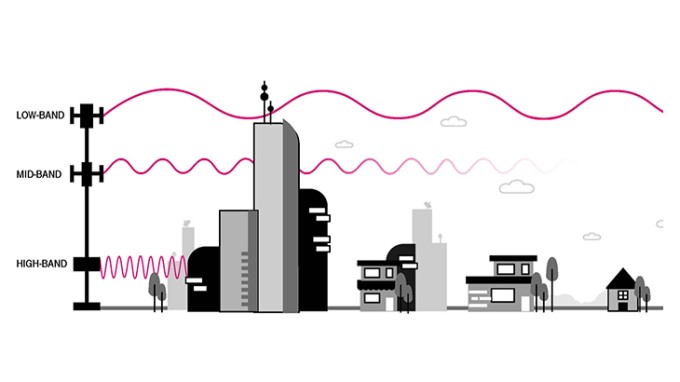5G Frequency Bands Explained
What is 5G?
5G is the fifth-generation technology for cellular networks. It promises to deliver blazing fast speeds, low latency, massive capacity, and greater reliability. The capabilities of such a network go far beyond telecommunication. After all, it has the potential to replace traditional broadband internet. 5G will expand the Internet of Things (IoT) ecosystem and transform tons of industries. To cater to different applications, 5G operates across several frequency bands.
We fix poor cell phone signal! Find the right signal booster for you:




What are 5G Frequency Bands?
5G devices and 5G towers communicate wirelessly via radio waves. These radio waves are tuned to specific frequencies within the radio spectrum allocated for 5G.
5G frequency bands are made up of a range of frequencies. Cellular carriers own sections of different bands to build their 5G network. Speed and range of 5G cellular signals will vary depending on where the 5G frequencies fall within the spectrum.
5G Spectrum – What Frequencies Does 5G Use?
 Image Source: T-Mobile
Image Source: T-Mobile
The radio spectrum ranges from 3 kHz to 300 GHz. 5G frequencies are divided between the Sub-6 GHz range (frequencies below 6 GHz) and mmWave range (starting at 24 GHz). Sub-6 5G can be broken down into Low-Band 5G and Mid-Band 5G.
The 5G spectrum is made up of three layers: Low-Band, Mid-Band, and High-Band (aka mmWave).
Low-Band 5G
You may know this band as “Nationwide 5G” because of Verizon or “Extended Range 5G” because of T-Mobile. Whatever you call it, Low-Band 5G refers to frequencies between 600 MHz to 1 GHz. Some sources say it covers up to 2.3 GHz. This frequency range is adjacent to where 4G and 3G networks operate, making it very important for 5G deployments. Carriers used existing spectrum and infrastructure to quickly deploy 5G on top of existing networks. This explains the recent 3G shutdown process: those frequencies are being reclaimed for 5G.
Since it's on the lower end of the 5G spectrum, Low-Band 5G frequencies have greater range and aren't as easily affected by obstacles. Speed can be slightly faster than 4G at times. Though, it's not noticeable most of the time. That may change in the future.
To coexist amongst 4G frequencies, Low-Band 5G uses Dynamic Spectrum Sharing (DSS) technology. This technology automatically allocates bandwidth between 4G and 5G based on demand. 4G traffic tends to take priority, which is why speeds aren't noticeably different. As more people upgrade to 5G devices, 5G traffic won't have to yield to 4G traffic, improving performance.
Mid-Band 5G
Mid-Band 5G spans from 1 GHz to 6 GHz, but it’s considered to be more in the 2.4 GHz to 4 GHz range. This is where the famous C-Band, ranging from 3.7 to 3.98 GHz, lives.
Mid-Band 5G can be thought of as the “Goldilocks” band. It can cover large areas and provide fast speeds that range from 300 Mbps to 1 Gbps. It blends speed, range, penetration, and capacity. Here is where you start to see performance that rivals traditional broadband internet. The C-Band section is supposed to be the ultimate sweet spot.
The main application for Mid-Band 5G will be in suburbs and cities where demand is considerably high.
High-Band 5G
The radio spectrum is scarce. So, to deliver on everything 5G claims, new frequencies were made available in the millimeter wave spectrum. Frequencies are much higher here.
High-Band 5G ranges from 24 to 39 GHz. This is where you’ll experience those blazing fast speeds and ultra-low latency 5G promises. It provides 1 Gbps speeds but can reach up to 10 Gbps under optimal conditions. Latency can be as low as 1ms. However, the trade off is range.
mmWaves can only travel short distances and can’t penetrate buildings. Waves are easily disrupted. Whether it be for signal boosting or 5G internet, 5G antennas and equipment will be needed to relay these signals inside buildings.
This spectrum is ideal for densely populated urban areas and busy venues. Featuring higher capacity, the network will be able to handle more devices at a time. Unreliable connectivity due to high traffic can be significantly mitigated with High-Band 5G.
Out of all 5G layers, this one will take the longest to deploy. Since 4G frequencies don’t operate in the mmWave, carriers can’t piggyback on existing infrastructure.
How Do I Connect to Different 5G Bands?
5G devices are programmed to automatically pick up available 5G frequencies. You don’t need to do anything to stay connected to the 5G network. However, if you’re in an area not covered by 5G, devices will fall back on 4G and LTE.
What is the Best Frequency for 5G?
Truth be told, there is no “BEST” frequency. They all cater to different demands. Low-Band 5G offers the most coverage, High-Band 5G provides the best speeds, and Mid-Band 5G excels at both.
Which 5G Band Is Fastest?
Higher frequencies provide faster data transmissions. By far, High-Band 5G or mmWave is the fastest 5G band. It offers speeds of 1 Gbps with the potential to reach up to 10 Gbps.
What 5G Frequencies Does Each Carrier Use?
Not all cellular carriers use the same 5G frequency bands. They purchase licenses for exclusive rights to specific frequencies that align with their goals.
| Carriers: | Low-Band 5G Freq: | Mid-Band 5G Freq: | High-Band 5G Freq: |
| AT&T 5G | 850 MHz: Band n5 | 3.4 GHz: Band n2 3.7 GHz: Band n77 |
24 GHz: Band n258 28 GHz: Band n261 39 GHz: Band n260 |
| Verizon Wireless 5G | 850 MHz: Band n5 1700/2100 MHz: Band n66 1900 MHz: Band n2 |
3.7 GHz: Band n77 | 28 GHz: Band n261 39 GHz: Band n260 |
| T-Mobile 5G | 600 MHz: Band n71 | 2.5 GHz: Band n41 3.4 GHz: Band n2 3.7 GHz: Band n77 |
24 GHz: Band n258 28 GHz: Band n261 39 GHz: Band n260 47 GHz: Band n262 (Pending) |
| U.S. Cellular 5G | 600 MHz: Band n71 | 3.4 GHz: Band n77 3.7 GHz: Band n77 |
24 GHz: Band n258 28 GHz: Band n261 39 GHz: Band n260 |
| Cricket Wireless 5G | 850 MHz: Band n5 | 3.7 GHz: Band n77 | 39 GHz: Band n260 |
| Boost Mobile 5G | N/A | 2.5 GHz: Band n41 | N/A |
| Metro by T-Mobile 5G | 600 MHz: Band n71 | N/A> | 28 GHz: Band n261 39 GHz: Band n260 |
*This table is subject to change, as more frequencies are auctioned off for use.
Who Has Access to the Widest 5G RF Spectrum?
Thanks to the Sprint merger, T-Mobile has the most 5G spectrum. As the FCC auctions off more RF spectrum for 5G use, other carriers can catch up.
How Do I Know Which 5G Frequency Band I’m Connected To?
The easiest way to identify which 5G band you’re connected to is by looking at the 5G signal icon on your phone.
AT&T, Verizon, and T-Mobile all display the standard 5G icon when connected to low-band frequencies. The icon changes for Mid- and High-Band 5G. AT&T uses 5G+, T-Mobile uses 5G UC (Ultra-Capacity), and Verizon uses 5G UW (Ultra-Wideband).
To identify the exact 5G frequency band, signal strength apps, like Network Cell Info, can help. This method will only work for Android devices. Unfortunately, the Apple store doesn’t offer signal strength apps that work right now.
Why are 5G Bands Important?
Every year the number of cellular connected devices increases. This includes smartphones, security systems, cellular routers, and other cellular IoT units. Previous generation cellular frequencies could only support so many devices at a time. During congestion, speed and reliability drastically decrease. Eventually, capacity runs out.
5G allows more devices to use data faster and more efficiently. Using different bands isn’t just about a hulked-out cellular network. It opens the door for new use cases, such as smart cities, autonomous vehicles, digital health, drones, and much more. To deliver on the 5G promise, carriers must use a mix of 5G frequencies to cater to different data demands.
In rural environments where cell towers are sparse, coverage is more important to reach as many devices as possible. This is where Low-Band 5G will make a big impact. Data demand and traffic increase in the suburbs and cities. More capacity and speed are needed to keep devices connected. That’s what Mid-Band 5G and High-Band 5G will do.
How to Get Better 5G Signals Indoors?
Your environment and building material can impact indoor 5G coverage. Currently, there is no perfect way to improve 5G coverage in homes and offices. Though, the best option available is a 5G-ready cell phone signal booster. It uses:
- An external antenna to capture existing 5G signals
- Coaxial cable to bypass building materials
- An amplifier to enhance the signal
- An indoor antenna to rebroadcast the boosted signal indoors
There is one catch, though. Signal boosters only work with certain frequencies. The most common are 700 MHz, 850 MHz, 1700/2100 MHz, and 1900 MHz. The booster will only support 5G signals deployed on those bands, which are part of the low-band spectrum. To find out if signal boosters will work with your carrier's 5G network, click here.
As 5G evolves and technology adapts, more options will become available.
Our weBoost and WilsonPro signal boosters are 5G ready and work with all cellular providers. Wilson Amplifiers is the leading provider of home, office, and vehicle signal boosters. If you have any questions about 5G frequencies or need help finding a booster, we can help. Call (1-800-568-2723), email (sales@wilsonamplifiers.com), or chat with us.
Sources:
Interested in Learning More? Check Out Our Signal Boosting Info Center


Money Back Guarantee

Technical Support
